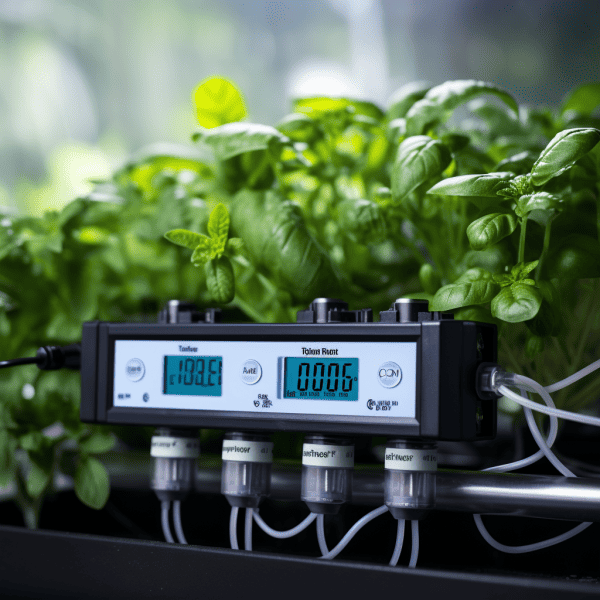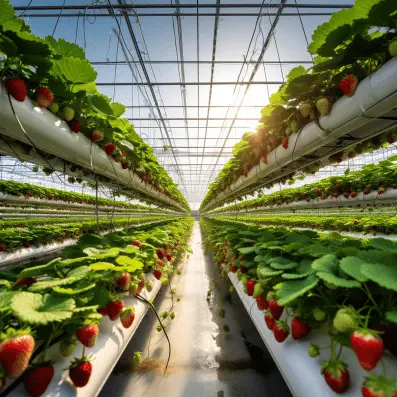As an avid hydroponic gardener, monitoring electrical conductivity is crucial for my plants’ health.
But as a beginner, grasping this unfamiliar concept took some learning.
What is EC and why does it matter in hydroponics?
Why is it important for understanding EC in hydroponics?
Let me break it down into simple terms.
EC measures the amount of dissolved minerals and nutrients in a hydroponic reservoir.
For plants to thrive, the nutrient solution must fall within an optimal EC range – not too little, not too much.
My first few hydroponic crops withered because I completely overlooked EC levels.
Once I started routinely testing and adjusting EC, my lettuce and tomatoes flourished beautifully!
Curious about how to leverage this important metric for gardening success? Read on to unlock the secrets of EC.
I’ll explain how taking quick EC readings can help you whip your nutrient solution into shape.
You’ll discover ideal EC targets for different plants and stages of growth.
I’ll also share my own tips for EC calibration and maintenance based on hard-won experience.
Take it from me, ignoring EC in your reservoir is just asking for lackluster crops.
Let’s explore this essential piece of the hydroponics puzzle together!
KEY TAKEAWAY
Understanding EC in hydroponics, what should you know?
Understanding EC (Electrical Conductivity) in hydroponics is crucial (1) for maintaining optimal nutrient levels and plant health.
By monitoring and adjusting EC, hydroponic growers can ensure the proper balance of nutrients for their plants, leading to higher yields and healthier crops.
Introduction to Electrical Conductivity (EC) in Hydroponics
Electrical conductivity (EC) is a vital metric for hydroponic gardeners to understand.
In simple terms, hydroponic tools such as EC meter measures the concentration of dissolved salts and minerals in a nutrient solution.
For plants to properly absorb the elements they need from water, the EC must fall within an ideal range.
As a hydroponics enthusiast, getting a handle on EC made all the difference for my plants.
I use an EC meter to test my reservoir’s conductivity regularly.
This helps me spot and correct any imbalances fast, so my crops get perfectly tuned nutrition.
Read on for an in-depth primer on EC for blossoming hydroponic gardens!
Importance of EC in Hydroponics: Nutrient Absorption and Plant Health

So why is tracking electrical conductivity so crucial for hydroponics (2)? Since plants in water culture depend completely on the reservoir for minerals, the EC strongly impacts how well roots take up nutrients.
If EC is too low, plants struggle to absorb nutrients and growth slows. If EC is too high, excessive salt buildup can “burn” and damage roots.
My lettuce heads perked right up once I optimized my reservoir’s EC! Monitoring conductivity ensures plants get just the right diet.
Proper EC also affects the oxygen levels that root systems depend on.
And disease resistance improves when mineral nutrition is balanced.
So for hydroponic success, maintain your EC in the sweet spot!
Understanding EC Units and Measurement in Hydroponics
EC levels are measured in Siemens (S) or milliSiemens (mS).
Most hydroponic EC meters display a ppM (parts per million) conversion of Siemens.
Ideal ppM ranges for plants fall between 800-2500ppM depending on the crop.
Meters measure EC using two prongs that conduct a low voltage current through the water.
More dissolved salts and minerals conduit the current better, giving a higher EC reading.
It’s quick and easy!
Role of EC in Nutritional Balance and Plant Growth
Tuning your reservoir’s EC affects more than just the total dissolved nutrients.
It influences the relative proportions of key elements like nitrogen, phosphorus, and potassium that plants need to thrive.
For example, lowering the EC can correct an excess of particular minerals that starts hampering growth.
I cut the EC to address curling leaf tips from too much nitrogen.
Or raising the EC can provide a boost if plants show signs of deficiency.
Optimizing hydroponic EC is about finding the right equilibrium across all nutrients, not just increasing total salts.
I add individual mineral supplements to adjust nutrition profiles without shifting the overall conductivity too high.
Getting the EC “recipe” just right for each crop type, growth stage, and system parameters lets plants properly metabolize essential nutrients.
Healthy roots absorb a balanced mineral diet and transport it efficiently to foliage and fruits.
This metabolic harmony is why tuning EC is so critical!
Optimal EC Levels for Hydroponic Crop Production

Ideal EC targets vary based on plant type, root health, and growth phase.
Here are some general guidelines:
- Seedlings: 400-800 ppM – Lower EC for young roots.
- Vegetative Stage: 800-1400 ppM – As plants mature, increase EC.
- Flowering/Fruiting: 1400-1800 ppM – Higher EC for blooms and fruit.
- Late Growth: 1000-1200 ppM – Lower EC again nearing harvest.
These ranges apply to most vegetable and herb crops.
But particular plants like orchids prefer an EC on the lower end.
Start low and slowly increase conductivity as the crop develops.
With experience, you’ll dial in the perfect EC for each hydroponic plant variety.
Consistent monitoring and data tracking helps refine your nutritional approach.
Pay close attention and let the plants guide you!
Here are two more sections continuing the article:
Managing EC in Hydroponic Systems for Strong Plant Growth
To harness the full power of optimized EC for your hydroponic crops, you need to actively manage conductivity over the growth cycle.
Here are some tips:
- Monitor EC frequently using a calibrated meter. Test 1-2 times per week minimum.
- When refilling a reservoir, reset EC to the appropriate level for the plants’ current growth phase.
- As plants mature, gradually increase EC to encourage healthy development.
- Use supplements like calcium or magnesium to target nutritional needs without drastically shifting overall EC.
- During flowering/fruiting, maintain mid-level EC around 1400-1600 ppM.
Staying vigilant ensures your reservoir EC aligns with each crop’s needs.
Letting conductivity drift too low or high stresses plants.
A proactive, attentive approach leads to more robust hydroponic harvests.
Interpreting EC Readings: Effects on Yield and Quality
Fluctuating EC levels provide clues into how your nutrient recipe is impacting plant performance and crop quality:
- Dropping EC implies rapid mineral absorption by fast-growing plants. Time to replenish nutrients!
- Rising EC suggests roots aren’t taking up nutrients quickly enough. Try increasing aeration.
- Low EC can limit flowering and fruit production, reducing yields.
- High EC from excess salts stunts growth and gives small, poor quality yields.
- Balanced EC enables plants to achieve maximum size, bloom, and fruit potentials.
Let your EC readings guide adjustments for unlocking each plant’s genetic potential.
The conductivity feedback loop is essential for dialing in optimal hydroponic nutrition.
Monitoring and responding to electrical conductivity empowers hydroponic gardeners.
With the science demystified, you can leverage EC for more vigorous, high-yielding crops!
Practical Applications: Measuring and Adjusting EC in Hydroponics
Once you understand the importance of electrical conductivity, it’s time to apply that knowledge!
Here are some tips for measuring and adjusting EC in your hydroponic system:
- Use a digital EC meter for quick, accurate readings. Calibrate it routinely in calibration solution.
- Test EC before adding any new supplements or replenishing reservoir water. This gives a baseline.
- Measure EC in multiple locations in the tank and average readings. It can vary in different spots.
- Adjust EC up by adding concentrated nutrient solutions or individual mineral supplements.
- Lower EC by doing a partial water change to dilute the reservoir.
- Only make EC adjustments in small increments.
Drastic shifts stress plant roots.
With routine testing and moderate EC tweaking, you’ll hone in on the sweet spot for your setup and crops.
Strive for consistency once dialed in.
Troubleshooting Common EC Issues in Hydroponics
Even experienced hydroponic gardeners encounter EC problems.
Here are some common issues and fixes:
- Rising EC: Add airstones for oxygen, change reservoir water, inspect roots for rot.
- Dropping EC: Replenish nutrients, use less water-soluble supplements, inspect roots for growth.
- Low EC: Raise by adding more nutrient concentrate.
- High EC: Lower by diluting reservoir water.
- Inconsistent readings: Clean and recalibrate meter, check multiple locations.
Don’t let EC fluctuations throw you off course! Spot issues early and make calm, moderate adjustments.
With attentive conductivity management, your hydroponic garden will flourish.
Conclusion
Now that you understand the science behind electrical conductivity and its importance for healthy hydroponic plants, you can confidently monitor and adjust your reservoir’s EC.
Remember to regularly test your nutrient solution and aim for the ideal EC range for each crop.
Too low, and plants starve for minerals.
Too high, and you risk burning the roots.
Armed with the knowledge to optimize EC levels, you can witness amazing growth results.
Just watch those seedlings take off once you fine-tune your nutrients! Don’t forget basic maintenance like cleaning EC meters and replacing old reservoir water.
With some practice, balancing your hydroponic EC becomes second nature.
For even more hydroponic science tips, explore my articles on pH, nutrients, lighting, and more.
I love empowering home hydro growers with the knowledge to reap thriving gardens.
Don’t hesitate to contact me if you need an EC troubleshooting hand! Together, we can get those reservoirs balanced for green, gorgeous hydroponic harvests.
Get ready for your tastiest, most bountiful crops yet once you unlock the potential of EC.
Happy growing!
References
- https://hollandhorticulture.co.uk/news/why-ec-is-important-in-hydroponics/#:~:text=In%20hydroponics%2C%20EC%20is%20the,the%20quantity%20of%20available%20nutrients.
- https://extension.okstate.edu/fact-sheets/electrical-conductivity-and-ph-guide-for-hydroponics.html
Related Articles
Was this helpful?

Crystal Erickson is an agriculture enthusiast and writer with a passion for sustainable farming practices and community development. Growing up on a family farm in rural Iowa, Crystal developed a love for the land and a deep appreciation for the hard work and dedication required to make a farm successful.
After completing a degree in Agriculture and Environmental Science from Iowa State University, Crystal began her career as an agricultural journalist, covering stories and issues related to modern farming practices, crop management, and livestock production. She quickly established herself as a respected voice in the industry, known for her insightful reporting and thoughtful analysis.
Over the years, Crystal has written for a variety of publications, including Farm Journal, Successful Farming, and Modern Farmer, as well as contributing to several academic journals focused on sustainable agriculture and community development. Her work has been recognized with numerous awards, including the Iowa Farm Bureau’s Young Farmer Achievement Award and the National Association of Farm Broadcasting’s Farm Broadcaster of the Year.

